Green Wednesday: Reviving Salmon in Napa County + Growing Lemon Trees
By Cindy Watter, UC Master Gardener of Napa County and Kathleen Scavone, Environmental Contributor
Having endured fires in our own region and felt the power of global support, our hearts are with those impacted by the Los Angeles County fires. Napa Valley Features will donate 10% of all new paid subscriptions through January to aid relief efforts.
NAPA VALLEY, Calif. — Every Wednesday, Napa Valley Features includes posts from environmental voices and the UC Master Gardeners of Napa County who share research-based horticultural advice. Together, these contributors provide valuable insights into sustainable gardening practices and climate-related topics relevant to our region.
Summary of Today’s Stories
"Salmon, Napa River's Iconic Fish Species" by Kathleen Scavone, Environmental Contributor: A look at ongoing efforts to restore salmon habitats in the Napa River, including fish barrier removals and the positive impact of these projects on salmon populations.
"Early winter rains provide conditions conducive to replenishing Chinook salmon in the Napa River." - Kathleen Scavone
"Let UC Master Gardeners Help With Your Plant Problems" by Cindy Watter, UC Master Gardener of Napa County: Practical advice for diagnosing and addressing common lemon tree issues like yellowing leaves and pest damage, emphasizing sustainable care practices and the value of a local help desk.
"Chlorosis (leaf yellowing) has many possible causes. Overwatering, under-watering, lack of nutrients and pests are just a few." - Cindy Watter
Salmon, Napa River's Iconic Fish Species
By Kathleen Scavone
NAPA VALLEY, Calif. — Early winter rains provide conditions conducive to replenishing Chinook salmon in the Napa River. To further enhance salmon and steelhead fish habitat, it was deemed necessary to reduce or remove artificial barriers along fish migratory paths to ensure the survival and reproduction of those species. A recent Napa County Resource Conservation District newsletter entitled, “Breaking Barriers for Fish in the Napa River Watershed,” explains that their goal is to connect streams and community, restore fish habitats as well as revitalize local fish populations.
Martin Perales, an environmental scientist at Napa RCD, is enthusiastic about the Chinook salmon counts in the Napa River so far. The December 2024 count showed 97 live fish and 157 redds, or eggs, buried in gravel nests. Though, admittedly, fish numbers are far from historic counts. In the 1960s, steelhead and salmon were in such abundance in myriad streams and the Napa River that horses would spook while attempting a water crossing. But the numbers are still encouraging. Perales explained that the springtime numbers will give a better picture of just how strong the salmon run is for 2025. The story, in pictures and video, of the iconic species of Napa County can be viewed in Napa RCD's Wild Salmon of the Napa River.
Migratory fish that depend upon the Napa River watershed begin life by laying and fertilizing eggs in gravely streambeds such as the headwaters of the Napa River around St. Helena and Calistoga. They require water that is 42 to 50 degrees Fahrenheit and is full of bubbling oxygen to survive. Thousands of eggs are laid, but only a couple fish will make the full cycle to come home and spawn again. Scientists believe that fish become imprinted through smell and the planet's magnetic field in order to come back to their place of birth.
After the fish hatch in cold water and grow to minnow-like size called “fry,” they acclimate to the saltwater conditions in the vicinity of the Trancas Street Bridge in Napa where the ocean tides push their way through the lower Napa River. Fry grow to become “smolts” and thrive in the salt marshes and wetlands near Vallejo, San Pablo and San Francisco Bay Estuaries and American Canyon. There, they prepare for their lives in the Pacific Ocean, where they will feed on smaller fish, shrimp and plankton. Then, miraculously enough, salmon and steelhead will, if they are lucky, make their way home to the Napa River once again. Steelhead will complete the reproduction cycle several times in their lives, while salmon's cycle occurs only once. Note: It's against the law to disturb adult steelhead and salmon.
Napa RCD is hard at work improving and maintaining the habitat and health of Napa County streams. Their Napa River Fish Barrier Plan was completed in 2011 and identified 19 high-priority sites throughout the Napa Valley (eventually narrowed down to 11) that would allow for over 33 miles of superior salmonid spawning and rearing habitat.
In 2024, Napa RCD was awarded $6.7 million by the National Oceanic and Atmospheric Administration to support their Fish Barrier Plan. Through work with public agencies and private landowners, restrictive fish barriers have been removed. The Fish Barrier removal project has included structures such as dams and road crossings and has made salmonid populations more likely to survive and thrive.
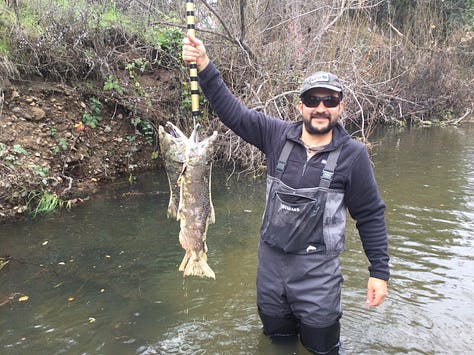
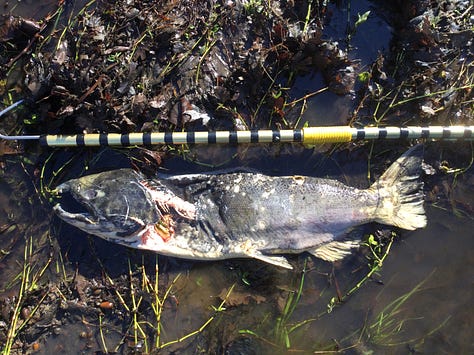
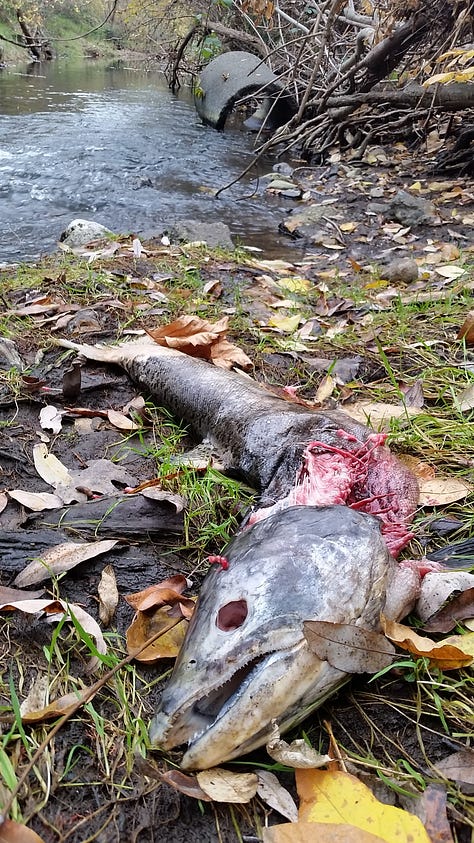
"In addition to the projects listed in the Fish Barrier Plan, state parks took out an old culvert at Bothe Napa Valley State Park at the junction of Redwood/Spring/Southfork/Ritchey trails, in order to create a better fish passage for steelhead,” said Jay Jessen, a park steward assistant for the Napa County Regional Park & Open Space District.
“My love for thriving ecosystems shapes both my approach to work and my vision for the Napa River watershed,” writes Perales on Napa RCD’s website. “I envision a vibrant river corridor that benefits both people and nature — one that provides the space and water needed to sustain abundant fish, wildlife and plant life, while also offering a place for people to enjoy and explore.”
Perales' photos for this article were taken during the annual Chinook spawner survey that took place in the recent winter months. The annual survey occurs each year near the first significant storm.
"This is when the bulk of Chinook salmon move into the Napa River to spawn,” Perales said. “The [above] photo shows me collecting otoliths from a carcass, which are the fish’s inner ear bones. These are used to determine the age of the fish and can also determine where that fish was spawned and reared. This is based on the microchemical signature that is stored in the otolith from when the fish was a juvenile in freshwater."
The incredible feat of fish returning to their natal source in these changing times is but one of many remaining mysteries and pleasures of the great outdoors in the Napa Valley. It's heartening indeed to find that the waterways of the county are becoming a haven once again to swords of fish infiltrating streams and rivers. If you know of a fish barrier or have one on your property that you would like removed, you can contact Perales at (707) 690-3117.
If today's story captured your interest, explore these related articles:
Birdwatching in Napa County Reveals Avian Wonders and Conservation Champions
Calistoga's Old Faithful Geyser: From Tourist Trap to Natural Wonder
Explore all Napa Valley Features stories on our main page.
Kathleen Scavone, M.A., retired educator, is a potter, freelance writer and author of “Anderson Marsh State Historic Park: A Walking History, Prehistory, Flora, and Fauna Tour of a California State Park,” "People of the Water" and “Native Americans of Lake County.” She loves hiking, travel, photography and creating her single panel cartoon called Rupert. She can be reached through her website.
Let UC Master Gardeners Help With Your Plant Problems
By Cindy Watter
NAPA VALLEY, Calif. — Most of us UC Master Gardeners are accustomed to being approached by people who think we know everything about horticulture. While flattering, that is not the truth. Our training has taught us how to find the answers, however. When a friend asked me why her lemon tree, despite diligent fertilization, had bright yellow leaves and was failing to thrive, I told her I would try to determine the problem.
UC Master Gardeners of Napa County operate a free help desk for home gardeners. The help desk is staffed on Mondays and Fridays from 10 a.m. to 1 p.m. You can either walk in with your question (bring a photograph or plant sample if possible) or you can email your question to mastergardeners@countyofnapa.org. A Master Gardener volunteer will get back to you. Again, a photograph of the problem is helpful.
We also have many resources on our website. Click on the “Gardening Resources” link and you’ll find a wealth of information, all University of California approved. There are Healthy Garden Tips, UC Master Gardener videos, a Napa County Vegetable Planting Guide and UC IPM’s Plant Problem Tool. (IPM stands for integrated pest management, which is shorthand for a variety of sustainable ways to control plant pests and disease.) If you are completely at sea with what is troubling a plant, this is a good place to start.
I am a decidedly low-tech person, but even I managed the Plant Problem Tool. There was a series of boxes to explore — plant types, plant names, plant parts, damage. I dutifully clicked plant types (fruit tree), then plant names (citrus), then plant parts (leaves) and damage (discolored, necrosis, chlorosis). These last two terms mean “dead” and “lack of chlorophyll.” I also researched holes in citrus leaves because my own patio Meyer lemon has a couple of yellow leaves with chewed edges.
I received 16 possible causes of my friend’s tree ailments, from aphids to wind injury. I decided aphids were my problem, so I am going to spray the leaves with water, buy some ladybeetles and advance to horticultural oil if needed. I thought my friend’s issue was likely mineral deficiencies, as her tree looked like one of King Midas’ accidents.
Citrus trees need regular irrigation and fertilization. Lemons can be fertilized with nitrogen at any time; early spring is a good time to start. Fertilizing three times a year is best practice. Citrus fertilizer, available at your local nursery, has twice as much nitrogen as phosphorus and potassium.
Iron deficiency is a possible cause of yellowing. Try adding a chelated fertilizer to the soil. A magnesium deficiency can also cause yellow leaves, and a home remedy for that is a good handful of Epsom salts scattered around the dripline of the plant. The dripline is where the water drips off the leaves onto the ground. The nutrients will reach the roots faster that way than if you fertilize and water around the trunk of the tree.
Mulching around citrus trees is advisable because mulch inhibits weeds that compete for nutrients. Keep the mulch away from the trunk. Monitor your soil moisture. If the soil is dry 2 inches below the surface, the tree needs water.
Chlorosis (leaf yellowing) has many possible causes. Overwatering, under-watering, lack of nutrients and pests are just a few. My friend’s lemon tree is in a pot, and she assures me that the potting soil is excellent. However, the pot has an open bottom. I wonder if the soil below is packed hard or has a lot of clay. That could affect nutrient absorption if the plant roots have moved down.
Testing the pH of the soil might reveal the source of the problem. If the soil pH is off, the tree can’t absorb nutrients, as I learned from a speaker from the Resource Conservation District at a recent Master Gardener class.
Lemon trees like a slightly acidic soil (pH less than 7). Alkaline soil will keep a lemon tree from absorbing nutrients and may cause chlorosis. You can buy a soil testing kit or use a local environmental testing lab.
I can look out my kitchen window and see a Meyer lemon tree across the street. It is loaded with lemons and its leaves are full and green. I have never seen it fertilized or watered or covered up during a freeze, and it is perfectly healthy. I would be more jealous of the owner’s success, but she is always giving me lemons.
One reason her tree is so healthy is that it was planted about 40 years ago, when Napa got more rain than it does now. Its roots are probably very deep, so it has access to moisture. It gets plenty of sun with its southwest exposure, and the soil in that yard is healthy, with lots of compost. The ladybeetles in the neighborhood eat plant pests. This is a lucky tree. It could live another 50 years.
Events
Library Talk: Join UC Master Gardeners of Napa County for a talk on “Planning a Cut Flower Garden,” on Thursday, March 6, from 7 to 8 p.m. via Zoom. This summer your garden can include beautiful, colorful flowers to cut and bring into your home. Join the UC Master Gardeners of Napa County to learn about the best annuals, biannuals and perennials for cutting, along with soil preparation tips, starting seeds indoors and direct seeding techniques. Click here to register!
Library Talk: Join UC Master Gardeners of Napa County for a talk on “Containing My Dahlia Enthusiasm,” on Thursday, Feb. 6, from 7 to 8 p.m. via Zoom. Dahlias produce dazzling flowers. However, rodents and other pests adore them as much as we do. Join the Master Gardeners of Napa County to learn how to best address these challenges and grow an abundance of show-stopping blooms in pots, gopher basket sand grow bags. Click here to register.
Help Desk: The Master Gardener Help Desk is available to answer your garden questions on Mondays and Fridays from 10 a.m. until 1 p.m. at the University of California Cooperative Extension Office, 1710 Soscol Ave., Suite 4, Napa. Or send your questions to mastergardeners@countyofnapa.org. Include your name, address, phone number and a brief description of the problem. For best results attach a photo.
If today's story captured your interest, explore these related articles:
Explore all Napa Valley Features stories on our main page.
Cindy Watter is a UC Master Gardener of Napa County.
—
The views, opinions and data presented in this article are those of the author and do not necessarily reflect the official policy, position or perspective of Napa Valley Features or its editorial team. Any content provided by our authors is their own and is not intended to malign any group, organization, company or individual.


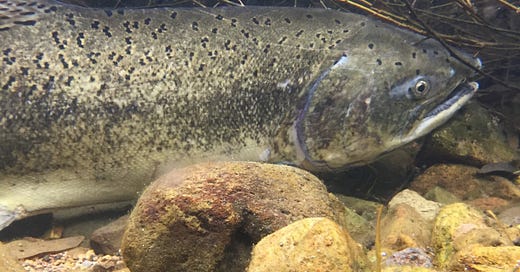




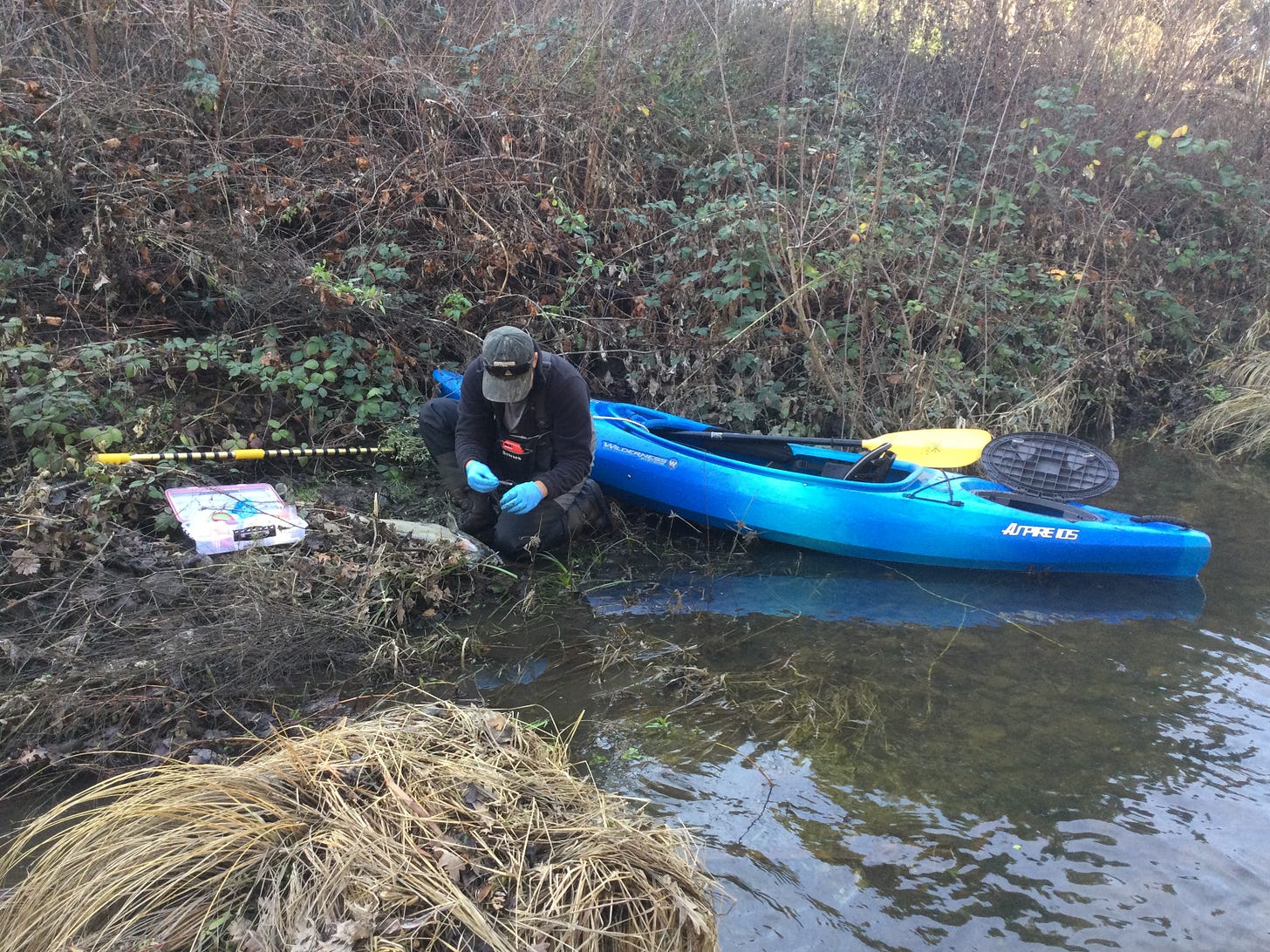

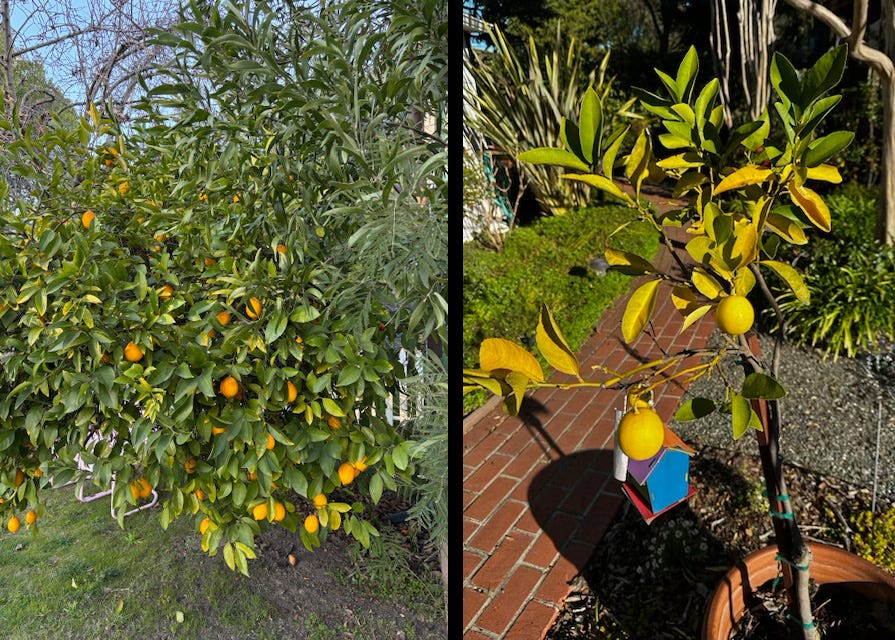
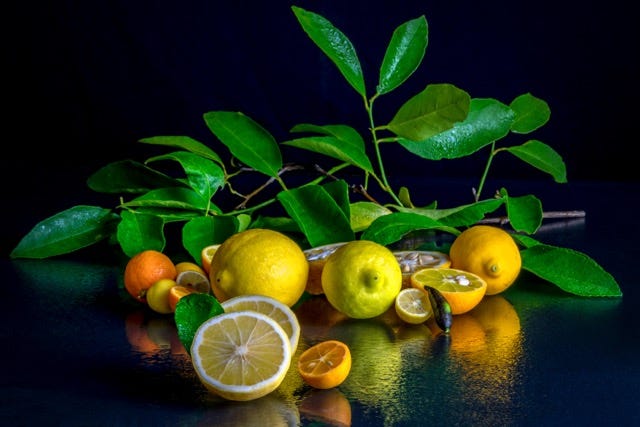

When the Napa River goes dry @ the St Helena Stone Bridge due to over pumping of Groundwater from St Helena's City Water Division using the 2 StoneBridge Wells for Municipal Drinking Water, it is a bad omen. All life in the River perished in the dry area. It did not need to be this way.
When I was a little kid moving to Napa in 1960 the river was filled with soap suds. I was aghast as I had never seen anything like that having moved from Sutter County. I am so glad that it is clean and productive now.